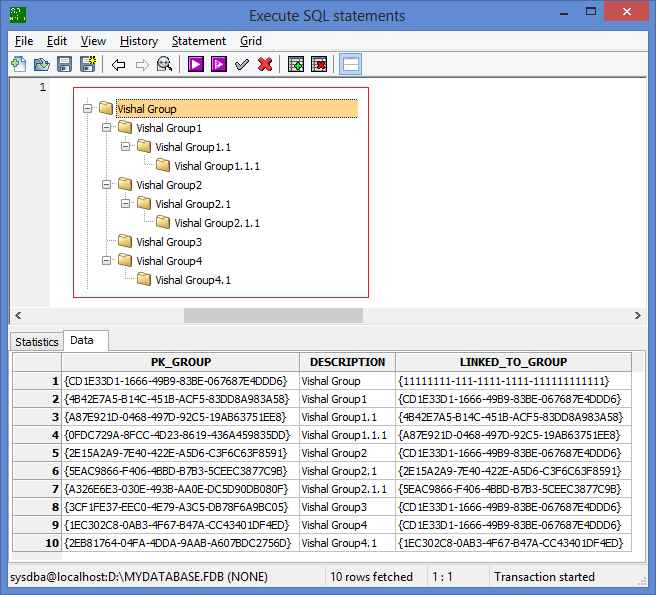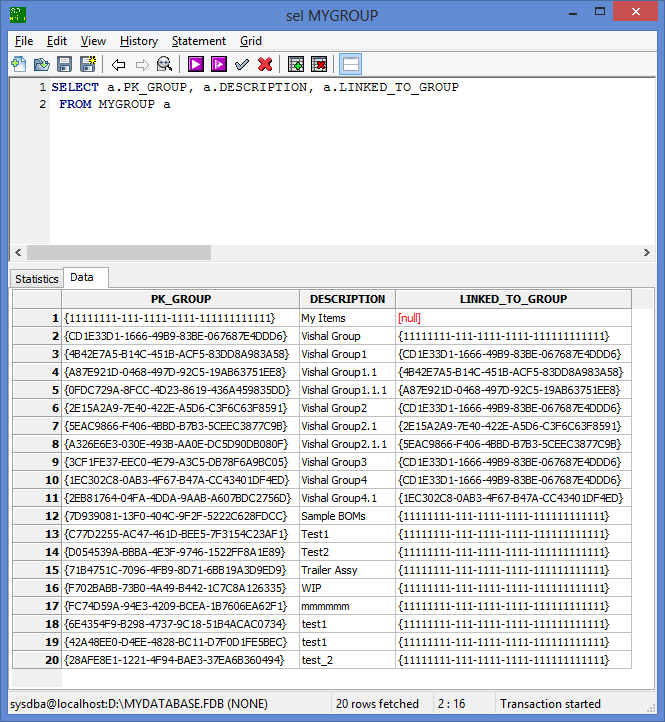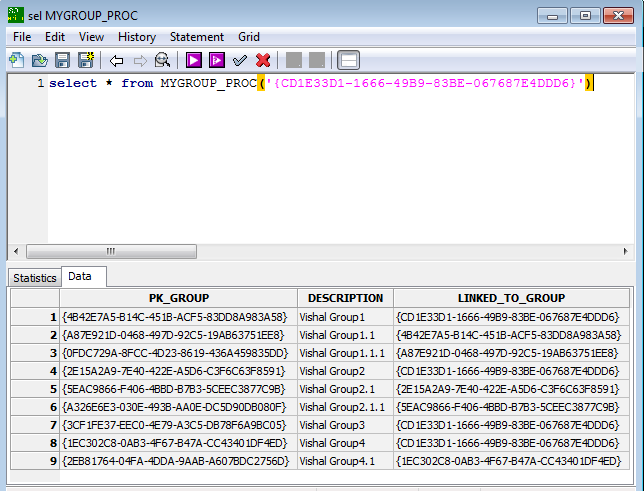In have table called "MYGROUP" in database. I display this table data in tree format in GUI as below:
Vishal Group
|
|-------Vishal Group1
| |-------Vishal Group1.1
| |-------Vishal Group1.1.1
|
|-------Vishal Group2
| |-------Vishal Group2.1
| |-------Vishal Group2.1.1
|
|-------Vishal Group3
|
|-------Vishal Group4
| |-------Vishal Group4.1
Actually, the requirement is, I need to visit the lowest root for every group, if that respective group is not used in other specific tables then I would delete that record from respective table.
I need to get all the details only for the main group called "Vishal Group", please refer to both snaps, one contains entire table data and the other snap (snap which has tree format details)shows expected data i.e. I need to get only those records as a result of a SQL execution.
I tried with self join (generally we do for MGR and Employee column relationship), but no success to get the records which falls under "Vishal Group" which is the base of all records.
I have added a table DDL and Insert SQL for reference as below. And also attached a snap of how data looks in the table.
CREATE TABLE MYGROUP
(
PK_GROUP GUID DEFAULT 'newid()' NOT NULL,
DESCRIPTION Varchar(255),
LINKED_TO_GROUP GUID,
PRIMARY KEY (PK_GROUP)
);
COMMIT;
INSERT INTO MYGROUP (PK_GROUP, DESCRIPTION, LINKED_TO_GROUP) VALUES ('{11111111-111-1111-1111-111111111111} ', 'My Items', NULL);
INSERT INTO MYGROUP (PK_GROUP, DESCRIPTION, LINKED_TO_GROUP) VALUES ('{CD1E33D1-1666-49B9-83BE-067687E4DDD6}', 'Vishal Group', '{11111111-111-1111-1111-111111111111}');
INSERT INTO MYGROUP (PK_GROUP, DESCRIPTION, LINKED_TO_GROUP) VALUES ('{4B42E7A5-B14C-451B-ACF5-83DD8A983A58}', 'Vishal Group1', '{CD1E33D1-1666-49B9-83BE-067687E4DDD6}');
INSERT INTO MYGROUP (PK_GROUP, DESCRIPTION, LINKED_TO_GROUP) VALUES ('{A87E921D-0468-497D-92C5-19AB63751EE8}', 'Vishal Group1.1', '{4B42E7A5-B14C-451B-ACF5-83DD8A983A58}');
INSERT INTO MYGROUP (PK_GROUP, DESCRIPTION, LINKED_TO_GROUP) VALUES ('{0FDC729A-8FCC-4D23-8619-436A459835DD}', 'Vishal Group1.1.1', '{A87E921D-0468-497D-92C5-19AB63751EE8}');
INSERT INTO MYGROUP (PK_GROUP, DESCRIPTION, LINKED_TO_GROUP) VALUES ('{2E15A2A9-7E40-422E-A5D6-C3F6C63F8591}', 'Vishal Group2', '{CD1E33D1-1666-49B9-83BE-067687E4DDD6}');
INSERT INTO MYGROUP (PK_GROUP, DESCRIPTION, LINKED_TO_GROUP) VALUES ('{5EAC9866-F406-4BBD-B7B3-5CEEC3877C9B}', 'Vishal Group2.1', '{2E15A2A9-7E40-422E-A5D6-C3F6C63F8591}');
INSERT INTO MYGROUP (PK_GROUP, DESCRIPTION, LINKED_TO_GROUP) VALUES ('{A326E6E3-030E-493B-AA0E-DC5D90DB080F}', 'Vishal Group2.1.1', '{5EAC9866-F406-4BBD-B7B3-5CEEC3877C9B}');
INSERT INTO MYGROUP (PK_GROUP, DESCRIPTION, LINKED_TO_GROUP) VALUES ('{3CF1FE37-EEC0-4E79-A3C5-DB78F6A9BC05}', 'Vishal Group3', '{CD1E33D1-1666-49B9-83BE-067687E4DDD6}');
INSERT INTO MYGROUP (PK_GROUP, DESCRIPTION, LINKED_TO_GROUP) VALUES ('{1EC302C8-0AB3-4F67-B47A-CC43401DF4ED}', 'Vishal Group4', '{CD1E33D1-1666-49B9-83BE-067687E4DDD6}');
INSERT INTO MYGROUP (PK_GROUP, DESCRIPTION, LINKED_TO_GROUP) VALUES ('{2EB81764-04FA-4DDA-9AAB-A607BDC2756D}', 'Vishal Group4.1', '{1EC302C8-0AB3-4F67-B47A-CC43401DF4ED}');
INSERT INTO MYGROUP (PK_GROUP, DESCRIPTION, LINKED_TO_GROUP) VALUES ('{7D939081-13F0-404C-9F2F-5222C628FDCC}', 'Sample BOMs', '{11111111-111-1111-1111-111111111111}');
INSERT INTO MYGROUP (PK_GROUP, DESCRIPTION, LINKED_TO_GROUP) VALUES ('{C77D2255-AC47-461D-BEE5-7F3154C23AF1}', 'Test1', '{11111111-111-1111-1111-111111111111}');
INSERT INTO MYGROUP (PK_GROUP, DESCRIPTION, LINKED_TO_GROUP) VALUES ('{D054539A-BBBA-4E3F-9746-1522FF8A1E89}', 'Test2', '{11111111-111-1111-1111-111111111111}');
INSERT INTO MYGROUP (PK_GROUP, DESCRIPTION, LINKED_TO_GROUP) VALUES ('{71B4751C-7096-4FB9-8D71-6BB19A3D9ED9}', 'Trailer Assy', '{11111111-111-1111-1111-111111111111}');
INSERT INTO MYGROUP (PK_GROUP, DESCRIPTION, LINKED_TO_GROUP) VALUES ('{F702BABB-73B0-4A49-B442-1C7C8A126335}', 'WIP', '{11111111-111-1111-1111-111111111111}');
INSERT INTO MYGROUP (PK_GROUP, DESCRIPTION, LINKED_TO_GROUP) VALUES ('{FC74D59A-94E3-4209-BCEA-1B7606EA62F1}', 'mmmmmm', '{11111111-111-1111-1111-111111111111}');
INSERT INTO MYGROUP (PK_GROUP, DESCRIPTION, LINKED_TO_GROUP) VALUES ('{6E4354F9-B298-4737-9C18-51B4ACAC0734}', 'test1', '{11111111-111-1111-1111-111111111111}');
INSERT INTO MYGROUP (PK_GROUP, DESCRIPTION, LINKED_TO_GROUP) VALUES ('{42A48EE0-D4EE-4828-BC11-D7F0D1FE5BEC}', 'test1', '{11111111-111-1111-1111-111111111111}');
INSERT INTO MYGROUP (PK_GROUP, DESCRIPTION, LINKED_TO_GROUP) VALUES ('{28AFE8E1-1221-4F94-BAE3-37EA6B360494}', 'test_2', '{11111111-111-1111-1111-111111111111}');
COMMIT;
Any idea how to get records which falls under "Vishal Group" ?




mysql,postgresql,sql-server,oracleordb2- or something else entirely. – Radial